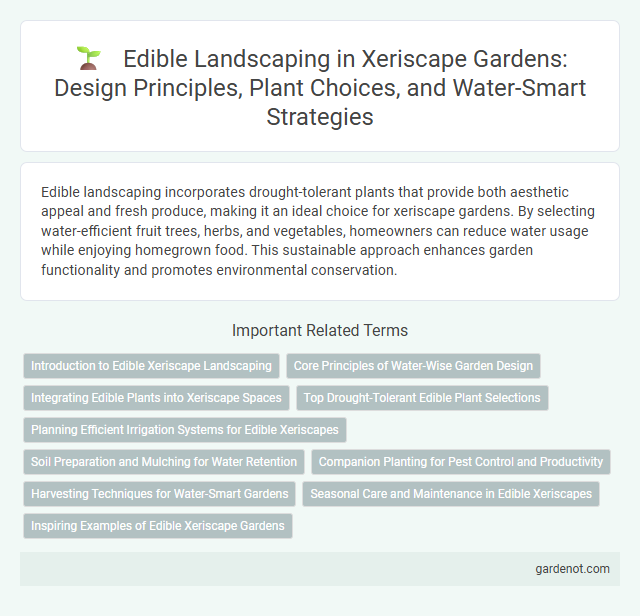Edible landscaping incorporates drought-tolerant plants that provide both aesthetic appeal and fresh produce, making it an ideal choice for xeriscape gardens. By selecting water-efficient fruit trees, herbs, and vegetables, homeowners can reduce water usage while enjoying homegrown food. This sustainable approach enhances garden functionality and promotes environmental conservation.
Introduction to Edible Xeriscape Landscaping
Edible xeriscape landscaping combines water-efficient gardening with productive food plants, optimizing arid environments for sustainable agriculture. Utilizing drought-tolerant fruits, vegetables, and herbs minimizes water consumption while enhancing soil health and biodiversity. This approach supports resilient food systems and reduces irrigation demands in regions prone to water scarcity.
Core Principles of Water-Wise Garden Design
Edible landscaping in xeriscape integrates drought-tolerant fruit trees, herbs, and vegetables that thrive with minimal irrigation. Key water-wise garden design principles include efficient water use through drip irrigation, soil improvement with organic mulch to retain moisture, and plant selection based on native or drought-resistant species. This approach maximizes yields while conserving water, creating sustainable, low-maintenance edible gardens ideal for arid climates.
Integrating Edible Plants into Xeriscape Spaces
Integrating edible plants into xeriscape landscapes maximizes water efficiency while providing fresh produce. Drought-tolerant varieties such as rosemary, thyme, and pomegranate thrive in xeriscape conditions, reducing irrigation needs. Combining native edible species with strategic mulching and drip irrigation enhances soil moisture retention and sustains plant health in arid environments.
Top Drought-Tolerant Edible Plant Selections
Top drought-tolerant edible plant selections for xeriscape gardens include native herbs like rosemary, thyme, and sage, which thrive in low-water conditions and enhance flavor in cooking. Succulent edibles such as prickly pear cactus and purslane provide nutrient-rich options while requiring minimal irrigation. These plants contribute to sustainable landscaping by conserving water and offering fresh produce in arid environments.
Planning Efficient Irrigation Systems for Edible Xeriscapes
Efficient irrigation systems for edible xeriscapes maximize water conservation by integrating drip irrigation and microsprayers tailored to plant water needs, significantly reducing runoff and evaporation. Careful zoning of plants with similar water requirements optimizes distribution and promotes healthy growth of fruit trees, herbs, and vegetable beds within the xeriscape. Smart irrigation controllers equipped with soil moisture sensors further enhance water use efficiency by adjusting watering schedules based on real-time environmental data.
Soil Preparation and Mulching for Water Retention
Edible landscaping with xeriscape principles requires careful soil preparation using organic matter to improve water retention and nutrient availability. Applying a thick layer of mulch, such as straw or wood chips, helps reduce evaporation, maintain consistent soil moisture, and suppress weed growth. These techniques optimize water efficiency and support healthy growth of drought-tolerant fruit and vegetable plants.
Companion Planting for Pest Control and Productivity
Edible landscaping with xeriscape principles enhances water efficiency while boosting garden productivity through companion planting techniques. Strategic pairing of plants like basil with tomatoes repels pests and improves growth, reducing the need for chemical pesticides. Incorporating drought-tolerant herbs such as rosemary and thyme alongside vegetables creates a resilient ecosystem that optimizes both pest control and harvest yield.
Harvesting Techniques for Water-Smart Gardens
Harvesting techniques in xeriscape edible landscaping emphasize minimal water use and plant health sustainability. Employing drip irrigation combined with timed harvesting improves water efficiency while enhancing crop yield. Techniques such as selective handpicking and staggered harvesting reduce plant stress and maximize resource conservation in water-smart gardens.
Seasonal Care and Maintenance in Edible Xeriscapes
Seasonal care and maintenance in edible xeriscapes require adapting irrigation schedules to the plants' growth cycles and prevailing weather conditions, ensuring optimal water efficiency. Pruning, mulching, and soil amendment are essential during seasonal transitions to promote plant health and sustain productivity. Monitoring pest activity and nutrient levels supports resilience and maximizes edible yield in drought-tolerant landscapes.
Inspiring Examples of Edible Xeriscape Gardens
Edible xeriscape gardens combine drought-tolerant plants with productive crops like kale, rosemary, and figs, maximizing water efficiency while providing fresh food. Examples such as the Southwest Garden in Tucson showcase how native succulents can coexist with fruiting shrubs like pomegranate, reducing irrigation needs by up to 60%. Incorporating rainwater harvesting systems and drip irrigation further enhances sustainability in edible xeriscaping.
Edible landscaping Infographic

 gardenot.com
gardenot.com